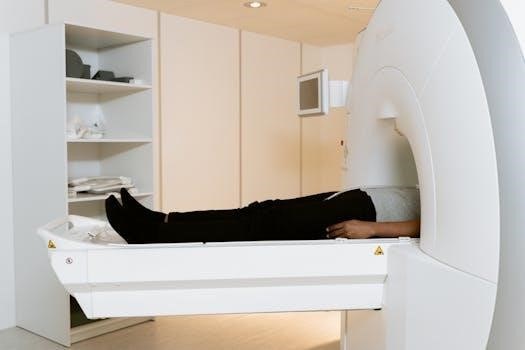Respiratory System Assessment⁚ A Comprehensive Guide
The respiratory system assessment involves gathering both subjective and objective data. This is achieved through a detailed interview and physical examination. The assessment focuses on the thorax and lungs. This comprehensive evaluation helps identify potential issues. These issues relate to the body’s ability to maintain adequate oxygen levels.
Respiratory assessment is a systematic evaluation of breathing. It aims to identify any alterations in respiratory function. This process requires a solid understanding of the respiratory system’s anatomy and physiology. A comprehensive respiratory assessment includes both subjective and objective components. This ensures a complete understanding of the patient’s condition.
The evaluation involves collecting data through detailed interviews and physical examinations. These examinations focus on the thorax and lungs. This assessment can provide significant insights into issues affecting oxygenation. Inadequate respiratory function can have substantial implications for a patient’s overall health. Accurate and timely observations are crucial for effective respiratory management.
A focused respiratory assessment includes specific techniques. These techniques involve inspecting consciousness levels‚ skin color‚ and breathing patterns. Assess for shortness of breath and use of accessory muscles. This systematic approach helps identify potential red flags and prioritize interventions. Respiratory distress can manifest through increased respiratory rate and changes in chest movement. Recognizing these signs is vital for prompt and appropriate care.

Anatomy and Physiology Overview
A foundational understanding of the respiratory system’s anatomy and physiology is essential. This understanding is crucial for conducting accurate respiratory assessments. The respiratory system comprises the upper and lower airways‚ lungs‚ and associated structures. These structures work together to facilitate gas exchange‚ supplying oxygen and removing carbon dioxide.
The upper airway includes the nose‚ sinuses‚ pharynx‚ and larynx. These structures warm‚ humidify‚ and filter incoming air. The lower airway consists of the trachea‚ bronchi‚ and bronchioles. These structures conduct air to the alveoli‚ where gas exchange occurs. The lungs‚ the primary organs of respiration‚ contain millions of alveoli‚ maximizing surface area for efficient gas exchange.
Respiration involves ventilation‚ perfusion‚ and diffusion. Ventilation is the mechanical process of moving air in and out of the lungs. Perfusion refers to blood flow through the pulmonary capillaries; Diffusion is the movement of oxygen and carbon dioxide across the alveolar-capillary membrane. Understanding these processes is essential for interpreting assessment findings and identifying respiratory dysfunction. Proper respiratory function is vital for maintaining overall health and well-being.

Subjective Assessment⁚ Interview Questions
The subjective assessment of the respiratory system begins with a detailed patient interview. This interview aims to gather information about the patient’s respiratory history and current symptoms. The interview guides the physical examination and subsequent patient education.
Key areas to explore during the interview include the patient’s chief complaint‚ history of present illness‚ and past medical history. Questions should address symptoms such as cough‚ shortness of breath‚ chest pain‚ and wheezing. Explore the characteristics of these symptoms‚ including onset‚ duration‚ severity‚ and aggravating or alleviating factors.
Inquire about the patient’s history of respiratory conditions such as asthma‚ COPD‚ pneumonia‚ or tuberculosis. Gather information about allergies‚ smoking history‚ and exposure to environmental pollutants. Also‚ ask about medications‚ including prescription‚ over-the-counter‚ and herbal remedies. Social history‚ including occupation and living environment‚ can provide valuable insights. Finally‚ explore family history of respiratory illnesses‚ as genetic factors can play a role. Effective communication is crucial for obtaining accurate and relevant information. Tailor questions to the individual patient and their specific concerns. This targeted approach helps to identify potential respiratory problems and guide further assessment.
Objective Assessment⁚ Physical Examination
The objective assessment of the respiratory system involves a hands-on physical examination. This examination includes inspection‚ palpation‚ percussion‚ and auscultation. Each component provides valuable information about the patient’s respiratory status.
Inspection begins with observing the patient’s overall appearance and vital signs. Assess their level of consciousness‚ breathing rate‚ and effort. Look for signs of respiratory distress‚ such as nasal flaring‚ accessory muscle use‚ or cyanosis. Observe the shape and symmetry of the chest wall‚ noting any deformities or abnormalities.
Palpation involves feeling the chest wall for tenderness‚ masses‚ or crepitus. Assess chest expansion by placing your hands on the patient’s back and observing the movement of your thumbs during inspiration. Percussion helps to assess the density of the underlying lung tissue. Listen for resonance‚ hyperresonance‚ or dullness. Auscultation involves listening to the breath sounds with a stethoscope. Identify normal breath sounds‚ such as vesicular‚ bronchovesicular‚ and bronchial sounds. Note any adventitious sounds‚ such as wheezes‚ crackles‚ or rhonchi. Document all findings accurately and compare them to previous assessments. This comparison is vital for tracking changes in the patient’s condition. The physical examination provides objective data to support the subjective findings from the patient interview.
Inspection of the Thorax
The initial step in a thorough respiratory assessment is a careful inspection of the thorax. This visual examination provides critical clues about the patient’s respiratory health. Begin by observing the anterior and posterior chest‚ noting its shape and symmetry. Look for any deformities‚ such as a barrel chest‚ pectus excavatum (sunken chest)‚ or pectus carinatum (pigeon chest). These deformities can affect lung function.
Assess the patient’s breathing pattern‚ including the rate‚ rhythm‚ and depth of respirations. Observe the use of accessory muscles‚ such as the sternocleidomastoid and intercostal muscles. Their use indicates increased work of breathing. Note the presence of any retractions‚ which occur when the soft tissue between the ribs pulls inward during inspiration. This suggests airway obstruction or respiratory distress.
Evaluate the skin color for signs of cyanosis‚ a bluish discoloration that indicates hypoxemia. Inspect the fingers for clubbing‚ a bulbous enlargement of the fingertips; This is often associated with chronic hypoxia. Observe the patient’s posture. A tripod position (leaning forward with hands on knees) can indicate respiratory distress. Finally‚ examine the intercostal spaces. Bulging or retraction of the spaces can provide further insight into the patient’s respiratory effort and potential underlying issues. Accurate observation is crucial for a comprehensive assessment.
Palpation Techniques

Following the initial inspection‚ palpation is the next crucial step in a comprehensive respiratory assessment. Palpation involves using your hands to physically examine the patient’s chest wall. This technique provides valuable information about underlying structures and potential abnormalities. Begin by gently palpating the anterior and posterior chest. Assess for any areas of tenderness‚ masses‚ or crepitus (a crackling sensation under the skin). Tenderness may indicate musculoskeletal issues or inflammation‚ while masses could suggest tumors or other lesions.
Next‚ evaluate chest expansion by placing your hands on the patient’s back with your thumbs meeting at the midline. Instruct the patient to take a deep breath and observe the movement of your thumbs. Normal chest expansion involves symmetrical movement of your hands outward. Asymmetrical expansion can indicate conditions such as pneumothorax or pneumonia.
Tactile fremitus is another important aspect of palpation. Place the palmar surface of your hands on the patient’s chest as they repeat a phrase like “ninety-nine.” Assess the intensity of the vibrations felt through the chest wall. Increased fremitus can indicate lung consolidation‚ while decreased fremitus may suggest pleural effusion or pneumothorax. Careful and systematic palpation techniques provide essential data for a thorough respiratory evaluation. These findings‚ when combined with inspection and auscultation‚ contribute to an accurate diagnosis and effective management plan.
Auscultation of Lung Sounds
Auscultation‚ the process of listening to lung sounds with a stethoscope‚ is a cornerstone of respiratory assessment. It allows the healthcare provider to evaluate airflow through the respiratory tree. This helps in identifying normal and abnormal breath sounds‚ which can indicate various respiratory conditions. To perform auscultation effectively‚ use the diaphragm of the stethoscope and listen directly on the patient’s skin. Avoid listening through clothing‚ as it can distort the sounds.
Instruct the patient to breathe slowly and deeply through their mouth. Systematically move the stethoscope across the chest wall‚ comparing sounds from side to side in corresponding locations. Normal breath sounds include vesicular‚ bronchovesicular‚ and bronchial sounds. Vesicular sounds are soft‚ breezy sounds heard over the peripheral lung fields. Bronchovesicular sounds are heard over the major bronchi and are moderate in pitch and intensity. Bronchial sounds are loud‚ high-pitched sounds heard over the trachea.
Abnormal or adventitious breath sounds include crackles (rales)‚ wheezes‚ rhonchi‚ and stridor. Crackles are discontinuous‚ popping sounds that can indicate fluid in the alveoli or airways. Wheezes are continuous‚ high-pitched whistling sounds caused by narrowed airways. Rhonchi are continuous‚ low-pitched snoring sounds that suggest secretions in the larger airways. Stridor is a high-pitched‚ crowing sound heard during inspiration. It indicates upper airway obstruction. Accurate auscultation requires practice and a thorough understanding of normal and abnormal lung sounds.
Assessing Respiratory Rate and Pattern
Assessing respiratory rate and pattern is a fundamental component of respiratory evaluation‚ providing crucial insights into a patient’s respiratory status. The respiratory rate‚ measured in breaths per minute‚ indicates how frequently the patient is breathing. The normal respiratory rate varies with age‚ but generally falls between 12 and 20 breaths per minute for adults. It is important to count the respiratory rate for a full minute‚ especially if the rhythm is irregular‚ to ensure accuracy. Observing the chest movement while seemingly taking the patient’s pulse can prevent them from consciously altering their breathing.
The respiratory pattern involves assessing the regularity‚ depth‚ and effort of each breath. Normal breathing should be even and unlabored‚ with consistent chest rise and fall. Abnormal breathing patterns can indicate underlying respiratory or metabolic issues. Tachypnea‚ or rapid breathing‚ can be caused by fever‚ anxiety‚ or respiratory distress. Bradypnea‚ or slow breathing‚ may result from medication effects‚ neurological conditions‚ or severe respiratory compromise. Apnea‚ or the absence of breathing‚ requires immediate intervention.
Specific breathing patterns such as Cheyne-Stokes respiration (gradual increases and decreases in depth‚ sometimes with periods of apnea) and Kussmaul’s breathing (deep‚ rapid‚ and labored breaths) can suggest serious medical conditions. It is equally important to note any use of accessory muscles‚ such as the sternocleidomastoid or intercostal muscles‚ which indicates increased work of breathing. Documenting the respiratory rate and pattern accurately is essential for tracking changes in the patient’s condition and guiding appropriate interventions.
Identifying Signs of Respiratory Distress
Recognizing signs of respiratory distress is crucial for prompt intervention and improved patient outcomes. Respiratory distress manifests as a combination of physiological and behavioral indicators‚ reflecting the body’s struggle to maintain adequate oxygenation and ventilation. One of the primary signs is an increased respiratory rate‚ or tachypnea‚ where the patient breathes faster than the normal range. This rapid breathing is an attempt to compensate for inadequate gas exchange.
Changes in breathing pattern are also indicative of respiratory distress. These include shallow breathing‚ where the depth of each breath is reduced‚ and labored breathing‚ characterized by visible effort and strain. The use of accessory muscles‚ such as the sternocleidomastoid‚ scalene‚ and intercostal muscles‚ signifies increased work of breathing. Nasal flaring‚ particularly in infants and young children‚ is another sign of increased respiratory effort.
Other important signs include abnormal breath sounds‚ such as wheezing‚ stridor‚ or diminished breath sounds‚ which can indicate airway obstruction or constriction. Cyanosis‚ a bluish discoloration of the skin and mucous membranes‚ suggests severe hypoxemia. Changes in mental status‚ such as confusion‚ agitation‚ or lethargy‚ can also result from inadequate oxygen supply to the brain. Restlessness and anxiety are common early indicators of respiratory distress. A thorough assessment‚ combining observation‚ auscultation‚ and monitoring of vital signs‚ is essential for accurately identifying respiratory distress and initiating timely treatment.
Use of Accessory Muscles
The utilization of accessory muscles during respiration is a significant clinical indicator of increased respiratory effort and potential respiratory distress. Under normal conditions‚ breathing is primarily facilitated by the diaphragm and intercostal muscles‚ operating with minimal conscious effort. However‚ when these primary muscles are insufficient to meet the body’s ventilatory demands‚ accessory muscles are recruited to assist in breathing.
The accessory muscles of respiration include the sternocleidomastoid‚ scalene‚ and trapezius muscles in the neck and upper chest‚ as well as the abdominal muscles. The sternocleidomastoid and scalene muscles elevate the rib cage‚ increasing the thoracic volume during inspiration. The trapezius muscles assist in lifting the shoulders‚ further expanding the chest. Visible contraction of these muscles during breathing indicates that the patient is working harder to breathe.
In conditions such as asthma‚ chronic obstructive pulmonary disease (COPD)‚ and pneumonia‚ airway obstruction or decreased lung compliance increases the effort required for breathing. As a result‚ accessory muscles are engaged to overcome these challenges. The use of accessory muscles is often accompanied by other signs of respiratory distress‚ such as nasal flaring‚ retractions‚ and increased respiratory rate. Assessing for the use of accessory muscles involves careful observation of the patient’s chest and neck during breathing. This clinical finding warrants further investigation to determine the underlying cause and guide appropriate interventions to support respiratory function.
Oxygenation Assessment⁚ Skin Color and Clubbing
Assessing oxygenation is a critical component of the respiratory assessment‚ and two key indicators are skin color and the presence of finger clubbing. Skin color provides a visual clue to the adequacy of oxygen delivery to the tissues. Normal skin color reflects sufficient oxygen saturation‚ while changes such as pallor or cyanosis can indicate hypoxemia‚ or low blood oxygen levels.
Pallor‚ or paleness‚ may suggest anemia or reduced blood flow‚ potentially impacting oxygen delivery. Cyanosis‚ a bluish discoloration of the skin and mucous membranes‚ is a more direct sign of hypoxemia. Peripheral cyanosis‚ affecting the extremities‚ may result from poor circulation‚ while central cyanosis‚ involving the lips and tongue‚ indicates significant oxygen desaturation in the arterial blood.
Finger clubbing‚ characterized by bulbous swelling of the fingertips and loss of the normal angle between the nailbed and nail‚ is a chronic sign of long-term hypoxemia. It is often associated with chronic respiratory conditions such as COPD‚ cystic fibrosis‚ and pulmonary fibrosis. The exact mechanism of clubbing is not fully understood but is thought to involve increased blood flow to the distal digits and release of growth factors. Assessing for clubbing involves inspecting the fingers and noting any changes in the shape and angle of the nailbed. The presence of either abnormal skin color or finger clubbing necessitates further evaluation‚ including pulse oximetry and arterial blood gas analysis‚ to determine the extent of hypoxemia and guide appropriate interventions.
Diagnostic and Monitoring Tools

Several diagnostic and monitoring tools are crucial in assessing and managing respiratory conditions. Pulse oximetry is a non-invasive method that measures the oxygen saturation of hemoglobin in the blood‚ providing an estimate of arterial oxygen levels. Arterial blood gas (ABG) analysis offers a more detailed assessment of oxygenation‚ ventilation‚ and acid-base balance‚ measuring partial pressures of oxygen and carbon dioxide‚ pH‚ and bicarbonate levels.
Pulmonary function tests (PFTs)‚ including spirometry‚ assess lung volumes‚ capacities‚ and airflow rates. These tests can help diagnose and monitor obstructive and restrictive lung diseases like asthma and COPD. Chest X-rays and CT scans provide visual images of the lungs and surrounding structures‚ aiding in the detection of pneumonia‚ tumors‚ and other abnormalities.
Sputum cultures are used to identify infectious agents in the respiratory tract‚ guiding antibiotic therapy for pneumonia and bronchitis. Bronchoscopy involves inserting a flexible tube with a camera into the airways to visualize the trachea and bronchi‚ allowing for tissue biopsies and removal of foreign objects. Capnography monitors the concentration of carbon dioxide in exhaled breath‚ providing information about ventilation and perfusion. These tools‚ used in combination with clinical assessment‚ enable healthcare professionals to accurately diagnose and manage respiratory disorders‚ optimizing patient outcomes.
Documentation and Reporting
Accurate documentation and reporting are paramount in respiratory system assessment. This ensures effective communication among healthcare providers and continuity of care. Comprehensive documentation should include subjective data obtained from the patient interview‚ such as chief complaints‚ history of respiratory illnesses‚ and current symptoms like dyspnea‚ cough‚ and chest pain.
Objective findings from the physical examination must be meticulously recorded. This includes observations of respiratory rate‚ rhythm‚ depth‚ and effort. Noteworthy findings are the use of accessory muscles‚ chest wall symmetry‚ and any abnormal breathing patterns. Auscultation results‚ detailing normal or adventitious breath sounds (wheezes‚ crackles‚ rhonchi)‚ should be clearly documented‚ along with their location and characteristics.
Results from diagnostic tests‚ such as pulse oximetry‚ arterial blood gas analysis‚ pulmonary function tests‚ and imaging studies‚ should be accurately transcribed and interpreted. Any interventions performed‚ such as oxygen administration‚ medication delivery‚ or airway management‚ along with the patient’s response‚ must be thoroughly documented. Timely reporting of significant findings or changes in the patient’s condition to the appropriate healthcare team members is crucial for prompt intervention and optimal patient outcomes. Clear‚ concise‚ and accurate documentation facilitates evidence-based practice and enhances patient safety.
